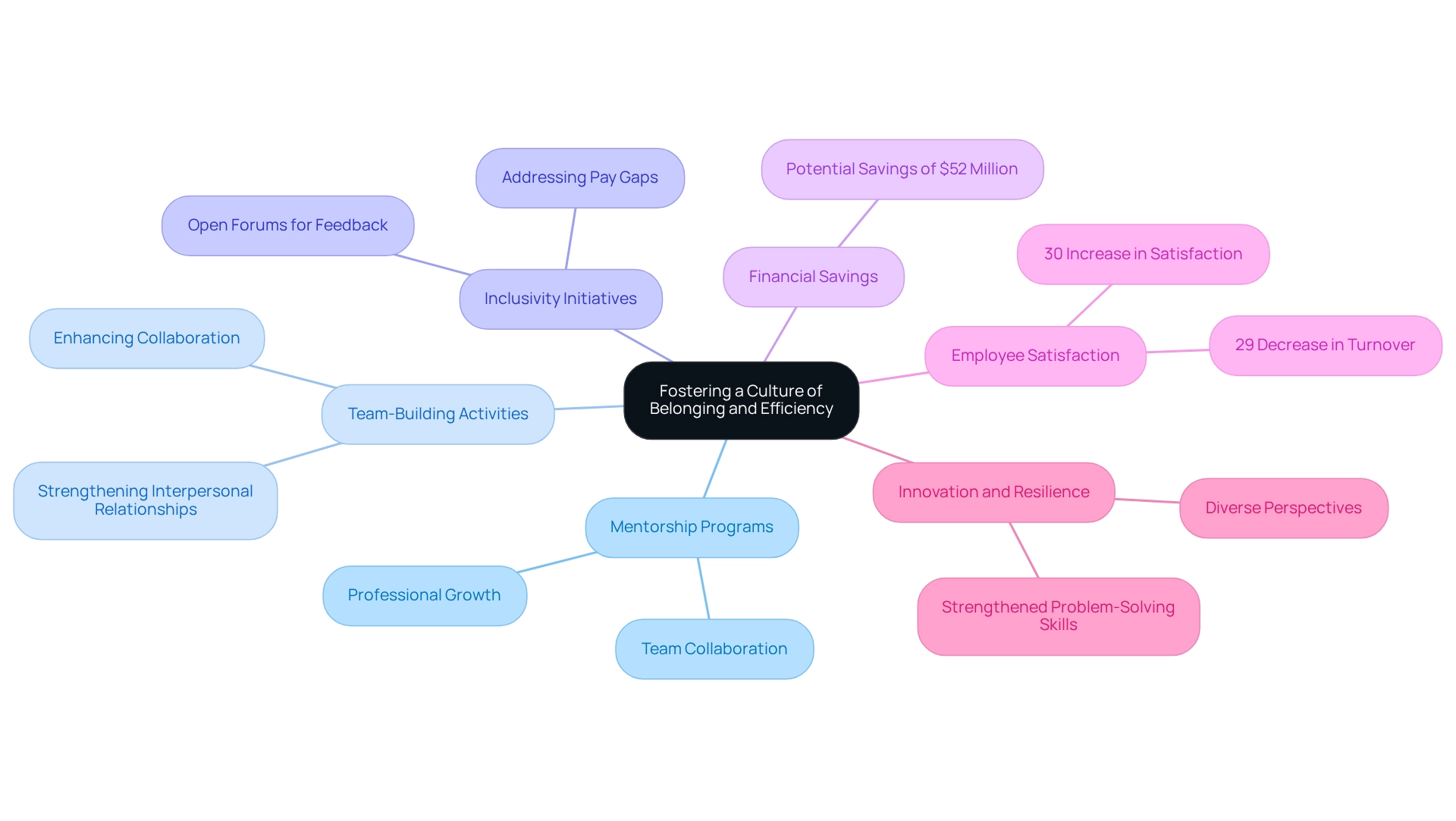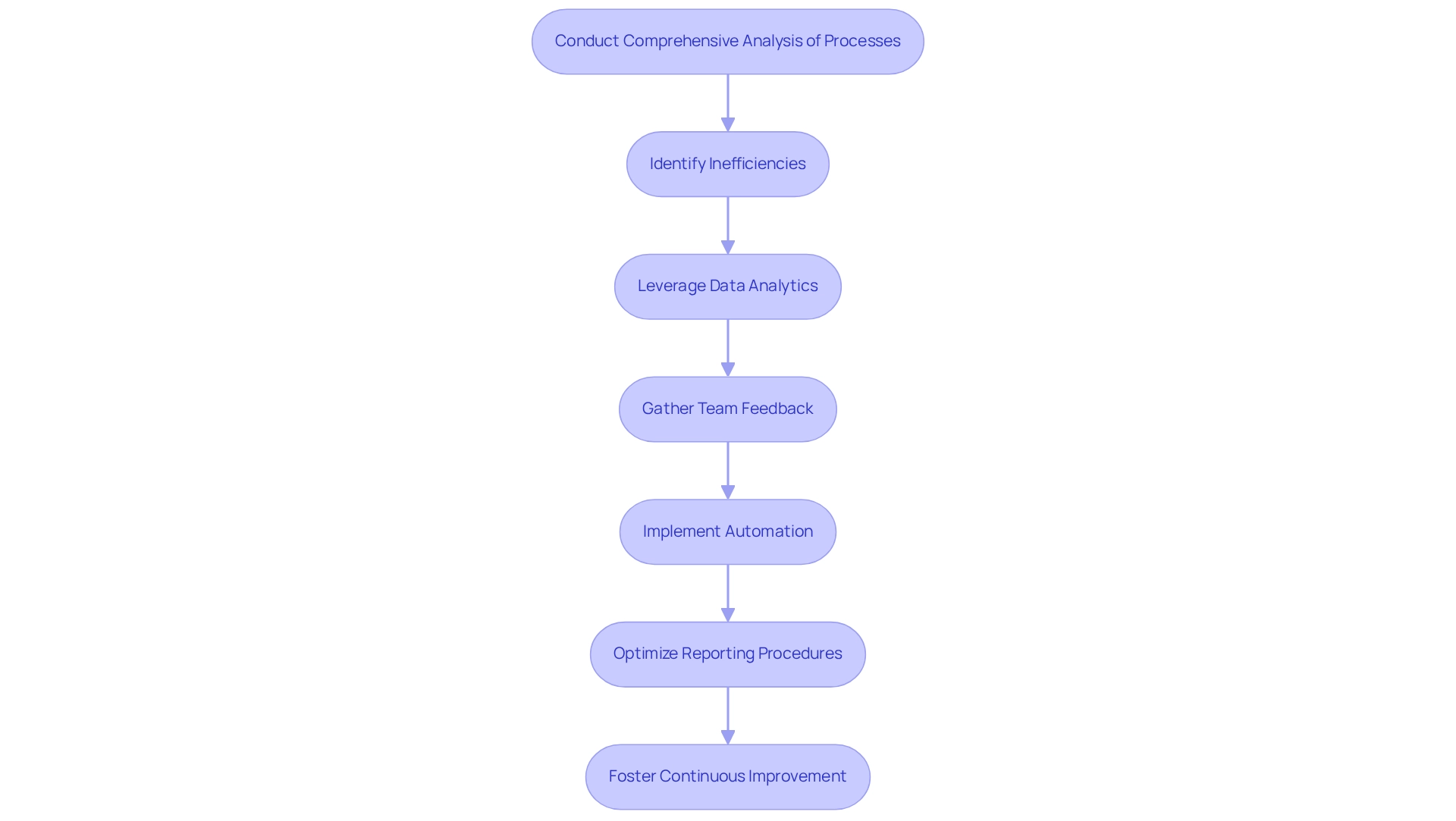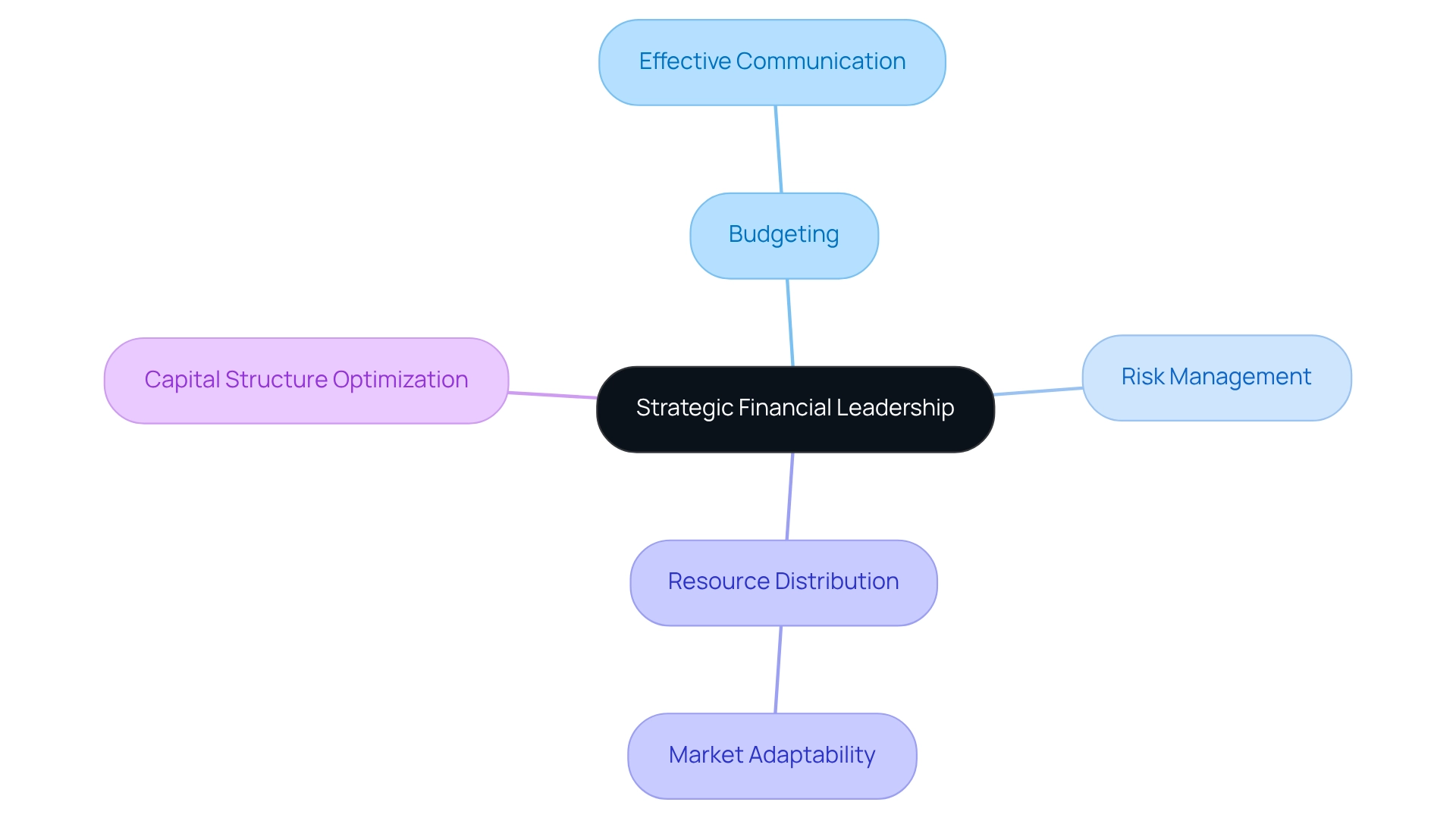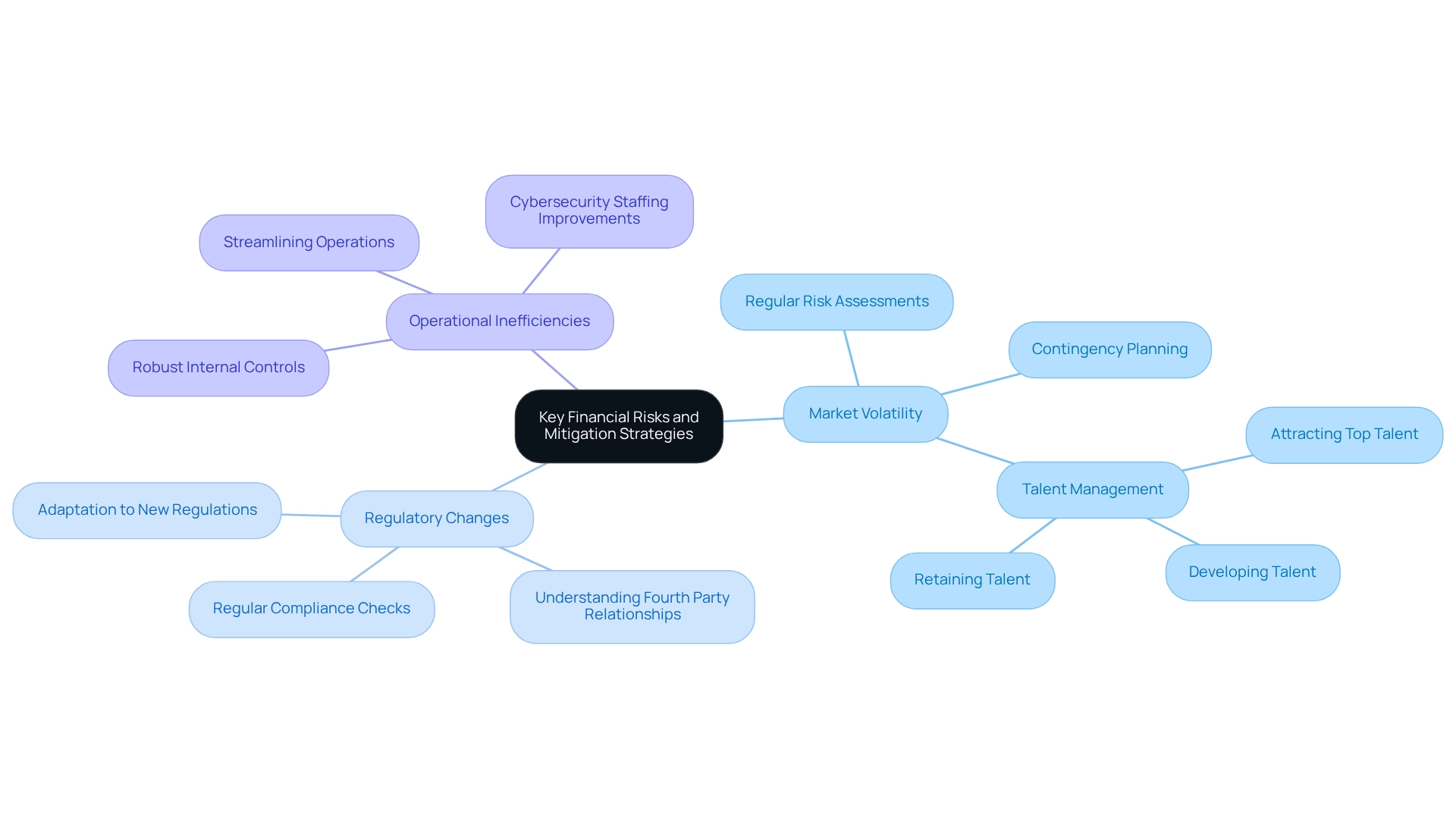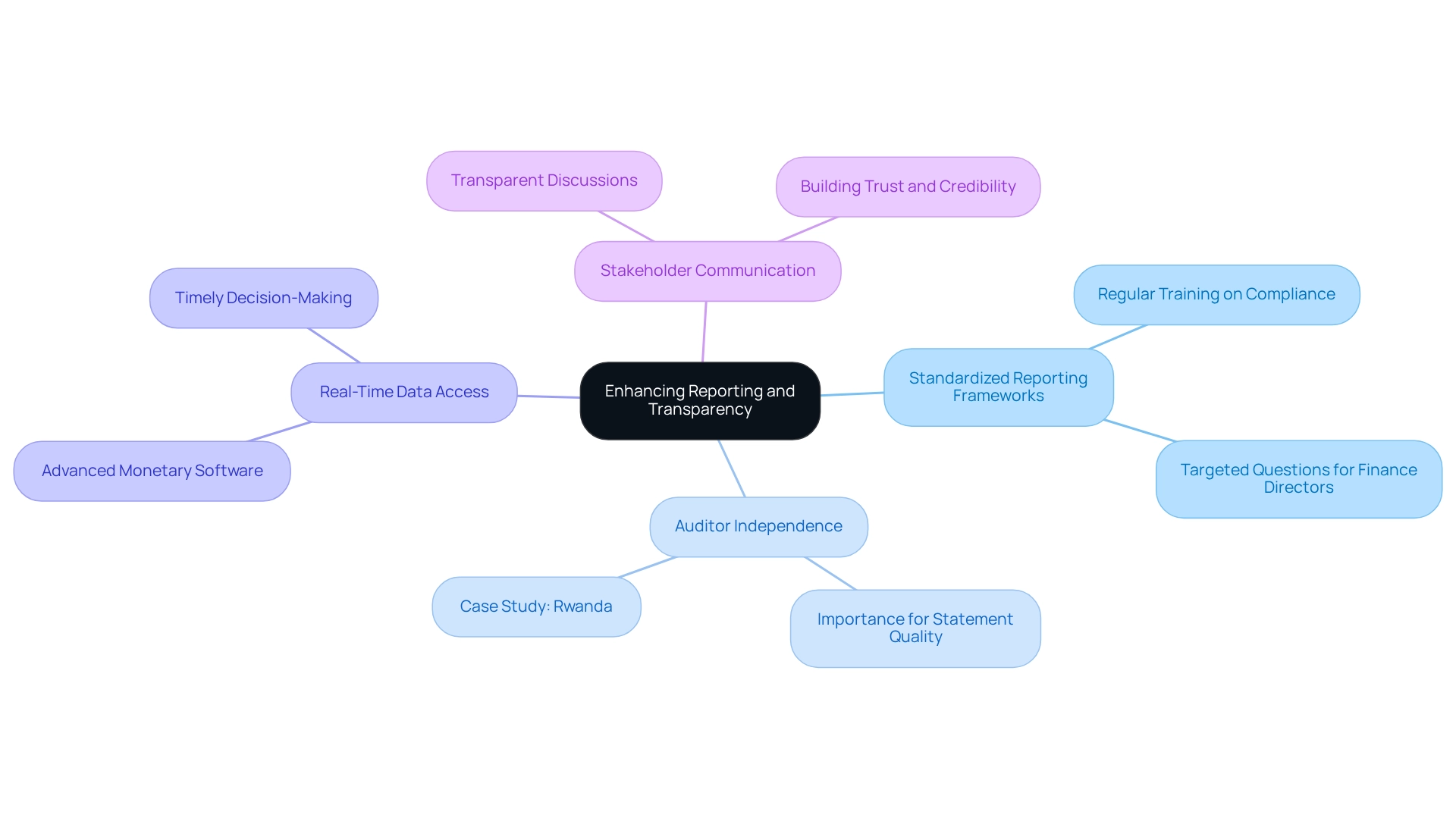Overview
This article addresses critical questions that finance directors must consider for effective leadership. It focuses on:
- Fostering a culture of belonging
- Enhancing operational efficiency
- Managing financial risks
By implementing:
- Mentorship programs
- Standardized reporting frameworks
finance directors can significantly improve team collaboration and transparency. Furthermore, proactive risk management and the automation of repetitive tasks not only enhance productivity but also mitigate potential financial challenges. Are you ready to elevate your leadership approach and drive your organization toward success?
Key Highlights:
- Mentorship programs and team-building activities can enhance collaboration and inclusivity within finance teams.
- Organizations with a strong sense of belonging can save over $52 million annually, demonstrating the financial benefits of inclusivity.
- Addressing pay equity leads to a 30% increase in employee satisfaction and a 29% decrease in turnover.
- Regular analysis of workflows and data analytics can identify inefficiencies in finance departments, especially with new regulatory requirements.
- Automation of repetitive tasks can significantly improve productivity and allow teams to focus on strategic initiatives.
- Frequent reviews of strategic initiatives enable organizations to adapt to market changes and drive growth.
- Key financial risks include market volatility, regulatory changes, and operational inefficiencies, which require proactive management.
- Regular risk assessments and robust internal controls are essential for mitigating financial risks.
- Standardized reporting frameworks enhance transparency and trust, crucial for effective leadership and organizational success.
- Investing in advanced financial software allows for real-time data access and improved stakeholder communication.
Introduction
In the realm of finance, the role of the finance director transcends mere number-crunching; it embodies the crucial responsibility of cultivating a culture that thrives on belonging, efficiency, and transparency. As organizations navigate an increasingly complex landscape, the significance of strategic financial leadership becomes paramount.
Finance directors are not only tasked with identifying and mitigating key financial risks but also with steering their teams toward operational excellence. This article delves into the multifaceted responsibilities of finance leaders, examining how they can drive business growth, enhance efficiencies, and instill trust through transparent reporting practices.
By embracing these principles, finance departments can significantly elevate their effectiveness and contribute to their organizations’ long-term success.
How Do You Plan to Foster a Culture of Belonging and Efficiency?
A financial director must clearly define strategies to cultivate an inclusive environment. This includes implementing mentorship programs that not only support professional growth but also enhance team collaboration. Regular team-building activities can strengthen interpersonal relationships, while open forums for feedback encourage transparency and inclusivity. By nurturing a sense of belonging, finance teams can greatly enhance collaboration and efficiency, which are essential for attaining optimal economic outcomes.
Research indicates that entities with high belonging can save substantial amounts annually—over $52 million for a company with 10,000 employees—demonstrating the financial benefits of such initiatives. Furthermore, companies that prioritize equity in the workplace, addressing pay gaps and ensuring equal pay for equal work, have reported a 30% increase in employee satisfaction and a 29% decrease in turnover. Providing employees with the necessary tools, resources, and opportunities to succeed is essential for achieving equity.
Additionally, organizations that embrace inclusivity are often more innovative and resilient, benefiting from diverse perspectives and ideas. Encouraging cross-functional interaction can strengthen problem-solving skills and align business objectives, further enhancing team effectiveness.
These outcomes underscore the essential role of inclusive practices in boosting employee engagement and retention. Are you ready to transform your finance team into a more resilient and innovative department? The time to act is now.
What Are Our Biggest Inefficiencies and How Can We Improve?
To enhance operational efficiency, directors must conduct a comprehensive analysis of existing processes to identify inefficiencies. This requires a detailed review of workflows, leveraging data analytics to monitor performance metrics, and gathering feedback from team members. Current statistics indicate that a significant number of finance departments are grappling with inefficiencies, with 99% of companies preparing for stricter disclosure requirements in response to new regulatory sustainability reporting mandates. This highlights the urgency of addressing these challenges, especially as many organizations pivot towards technological solutions.
Implementing solutions such as automating repetitive tasks can drastically reduce time spent on routine activities, allowing teams to focus on strategic initiatives. Optimizing reporting procedures and investing in advanced monetary technologies not only increases productivity but also improves accuracy and risk management abilities. A case study on automation in the monetary sector reveals key advantages: decreased time on routine tasks, enhanced accuracy, strategic value creation, and improved risk management.
Best practices for enhancing workflows in the monetary domain include regularly evaluating process performance, utilizing data analytics to uncover insights, and fostering a culture of continuous improvement. It is crucial to highlight that 13% of financial executives believe technological progress won’t affect their establishment in the next five years, emphasizing the necessity for leaders to adopt innovation. By prioritizing these strategies, leaders in the economy can significantly enhance their team’s performance and drive value creation within their organizations, particularly in the context of HR managers who play a crucial role in aligning talent with these evolving monetary processes.
What Commercial Value Can Your Strategic Financial Leadership Add?
A chief officer plays a pivotal role in driving business growth through strategic monetary leadership, encompassing effective budgeting, risk management, and resource distribution. By focusing on optimizing capital structure, financial leaders can significantly enhance profitability and uncover new revenue streams. Organizations that consistently review their strategic initiatives are better equipped to adapt to market fluctuations; however, nearly 25% of companies assess their strategy implementations only annually, potentially stifling their responsiveness.
In 2025, the impact of strategic monetary leadership on business growth is underscored by the fact that 98% of leaders believe that executing strategies takes longer than formulating them. This underscores the necessity for finance directors not only to develop robust monetary strategies but also to contemplate the critical questions regarding their effective implementation. Furthermore, with 80% of CFOs dedicating substantial time to engaging with their boards, clear communication becomes essential for aligning budgetary strategies with organizational objectives.
The case study titled “Frequency of Strategy Reviews” illustrates that entities prioritizing frequent evaluations of their economic strategies achieve superior alignment with evolving market conditions, ultimately propelling growth. As financial leaders emphasize the commercial value of their strategic initiatives, they foster a culture of continuous improvement and adaptability, which is vital for long-term success in a competitive landscape.
What Key Financial Risks Do You See and How Will You Mitigate Them?
Finance leaders must recognize and articulate the potential monetary risks that could impact their entities in 2025, including market fluctuations, regulatory adjustments, and operational inefficiencies. A well-structured risk management plan is essential, encompassing regular risk assessments, contingency planning, and the establishment of robust internal controls. By proactively addressing these risks, finance directors can safeguard the entity’s monetary integrity.
Key financial risks for organizations this year include:
- Market Volatility: Fluctuations in market conditions can significantly affect revenue and investment strategies. Statistics indicate that 26% of entities perceive the capacity to attract, develop, and retain top talent as a significant operational risk, exacerbating challenges during unstable times. Effective talent management is crucial for sustaining stability and ensuring that entities can adapt to evolving market conditions.
- Regulatory Changes: Adapting to new regulations is vital for compliance and operational efficiency. Organizations must remain informed about evolving regulations to mitigate potential penalties and operational disruptions. Furthermore, with 50% of entities having indirect relationships with at least 200 fourth parties that have experienced breaches, understanding these connections is essential for managing regulatory risks.
- Operational Inefficiencies: Inefficient processes can lead to increased costs and diminished profitability. Finance leaders should implement strategies to streamline operations and enhance productivity. For instance, entities facing challenges in cybersecurity staffing often report being short-staffed, which can hinder their ability to assess and evaluate cyber defenses effectively, resulting in monetary losses and heightened operational risks.
To effectively mitigate these risks, finance directors should consider the following strategies:
- Regular Risk Assessments: Conducting regular evaluations of monetary risks enables entities to stay ahead of potential challenges and adjust strategies accordingly.
- Contingency Planning: Developing contingency strategies ensures that entities are prepared for unforeseen economic difficulties, particularly those arising from market fluctuations, allowing for swift actions to minimize impacts.
- Robust Internal Controls: Implementing strong internal controls helps prevent fraud and operational inefficiencies, thereby safeguarding the entity’s assets.
As Heather Kane, a Broking Leader in the Financial Institutions and Professional Services Industry Division, observes, organizations that contemplate the questions to ask finance directors will be better positioned to remain vigilant and adaptable, seizing opportunities while maintaining stability amid uncertainty. This perspective underscores the necessity for finance leaders to adopt a proactive approach to risk management, ensuring their organizations remain resilient in shifting economic environments.
How Can We Enhance Reporting and Transparency to Strengthen Trust?
To enhance monetary reporting and transparency, finance directors must advocate for the adoption of standardized reporting frameworks. These frameworks are essential for ensuring consistency and clarity in monetary statements. The implementation of advanced monetary software can facilitate real-time data access, enabling timely decision-making and improved stakeholder communication. Regular updates and transparent discussions with stakeholders not only enhance clarity but also cultivate a culture of trust and credibility.
The significance of reporting transparency cannot be overstated; it is a cornerstone of effective leadership and organizational success. Firms that prioritize transparency often experience heightened market confidence and investor trust. Research indicates that auditor independence is linked to improved statement quality. A notable case study from Rwanda underscores the importance of maintaining auditor independence for detecting monetary misstatements, thereby elevating the overall quality of reporting.
As we approach 2025, the evolving economic landscape necessitates the implementation of strategies that bolster reporting transparency. Embracing standardized reporting frameworks will not only streamline processes but also enhance confidence in leadership. It is crucial to recognize that external economic factors, such as GDP growth rates and oil price fluctuations, can significantly impact stock market volatility, thereby influencing reporting practices. Financial leaders must remain vigilant of the challenges posed by firms struggling with transparency due to deliberate fraud or misleading information.
By committing to these practices and addressing these challenges, financial leaders can profoundly impact their entities’ reputations and operational efficiency. A practical step for finance directors is to establish a comprehensive framework for standardized reporting. This framework should include:
- Regular training for staff on compliance and transparency best practices
- Formulating targeted questions for finance directors to ensure that all team members align with the organization’s commitment to high-quality financial reporting
Conclusion
Cultivating a culture of belonging and efficiency within finance teams is paramount for achieving optimal financial outcomes. Implementing mentorship programs and prioritizing equity empowers finance directors to foster an inclusive environment that enhances collaboration and drives innovation.
Addressing inefficiencies through data analytics and automation significantly elevates operational performance. Streamlining workflows allows teams to concentrate on strategic initiatives, ensuring agility in responding to market demands.
Strategic financial leadership is indispensable for driving business growth. By optimizing capital structures and regularly reviewing strategies, finance directors adeptly navigate complexities. Clear communication aligns financial strategies with organizational goals, fostering adaptability.
Identifying and mitigating financial risks is crucial for protecting organizational integrity. Proactive risk management, including regular assessments and robust internal controls, enables finance directors to tackle challenges before they escalate, safeguarding assets.
Enhancing transparency in financial reporting builds trust. Adopting standardized frameworks and utilizing advanced financial software ensures clarity in communications, boosting investor confidence and reinforcing the organization’s reputation.
In summary, the role of finance directors encompasses fostering inclusivity, enhancing operational efficiency, providing strategic leadership, mitigating risks, and ensuring transparency. By prioritizing these areas, finance leaders can significantly elevate their impact and contribute to the long-term success of their organizations.
Frequently Asked Questions
What strategies can a financial director implement to cultivate an inclusive environment?
A financial director can implement mentorship programs to support professional growth and enhance team collaboration, conduct regular team-building activities to strengthen interpersonal relationships, and create open forums for feedback to encourage transparency and inclusivity.
What are the financial benefits of fostering a sense of belonging within finance teams?
Research indicates that companies with high belonging can save substantial amounts annually—over $52 million for a company with 10,000 employees—demonstrating the financial benefits of such initiatives.
How does prioritizing equity in the workplace affect employee satisfaction and turnover?
Companies that prioritize equity, address pay gaps, and ensure equal pay for equal work have reported a 30% increase in employee satisfaction and a 29% decrease in turnover.
What role does inclusivity play in innovation and resilience within organizations?
Organizations that embrace inclusivity benefit from diverse perspectives and ideas, which enhances innovation and resilience. Encouraging cross-functional interaction can also strengthen problem-solving skills and align business objectives.
What steps should directors take to enhance operational efficiency in finance departments?
Directors should conduct a comprehensive analysis of existing processes to identify inefficiencies, review workflows, leverage data analytics for performance monitoring, and gather feedback from team members.
What challenges are finance departments currently facing regarding inefficiencies?
A significant number of finance departments are grappling with inefficiencies, particularly as 99% of companies prepare for stricter disclosure requirements due to new regulatory sustainability reporting mandates.
How can automation improve operational efficiency in the finance sector?
Automating repetitive tasks can drastically reduce time spent on routine activities, allowing teams to focus on strategic initiatives, thus increasing productivity, accuracy, and risk management abilities.
What best practices should be followed to enhance workflows in the monetary domain?
Best practices include regularly evaluating process performance, utilizing data analytics to uncover insights, and fostering a culture of continuous improvement.
Why is it crucial for financial executives to adopt technological innovations?
It is crucial because 13% of financial executives believe technological progress won’t affect their establishment in the next five years, highlighting the necessity for leaders to adopt innovation to enhance team performance and drive value creation.
